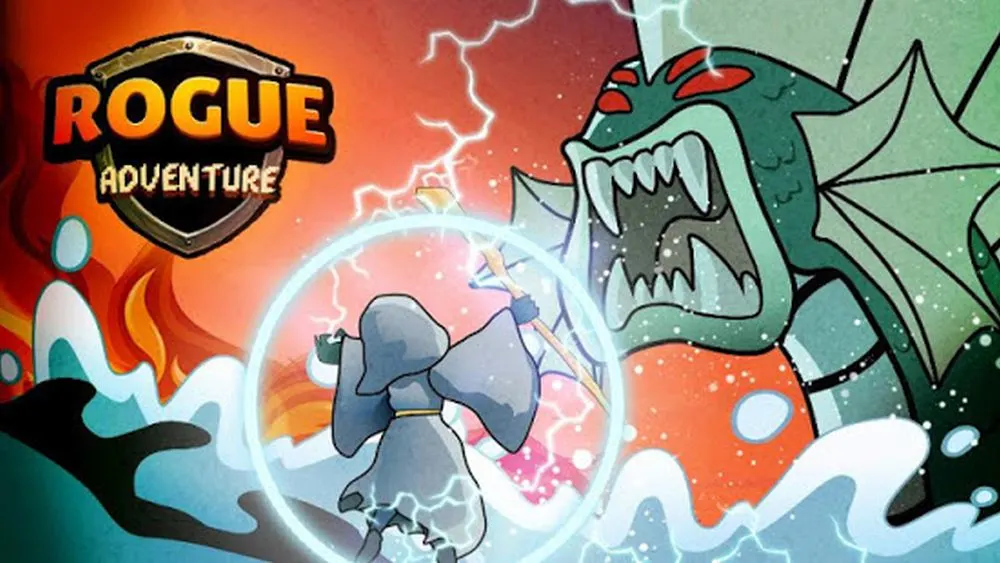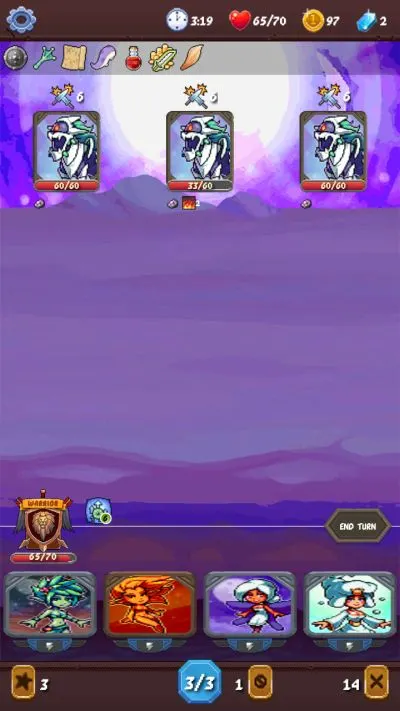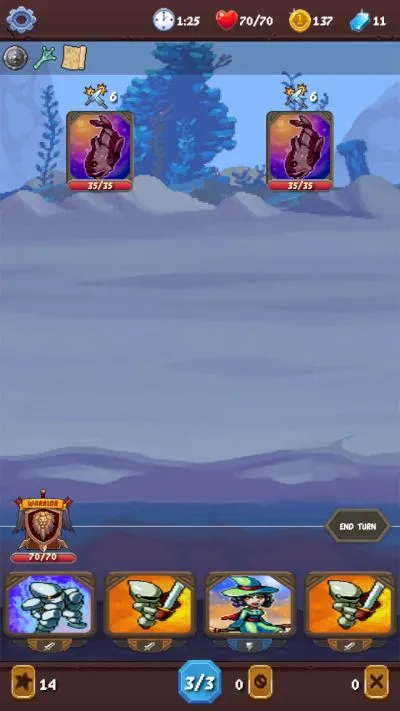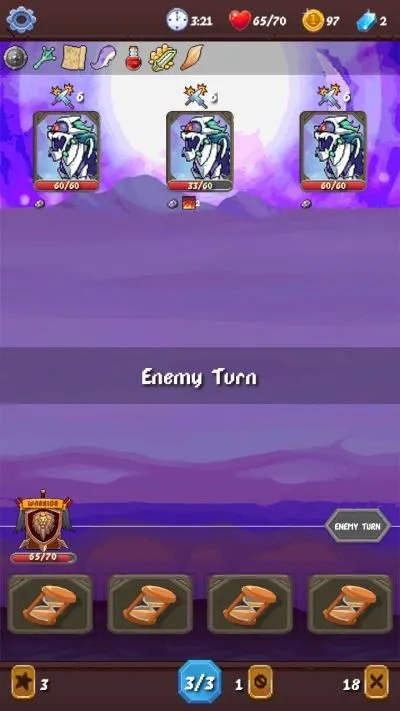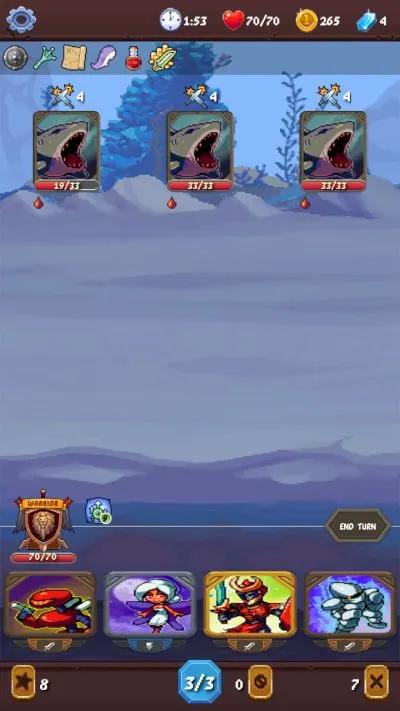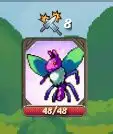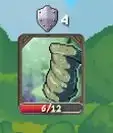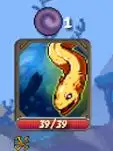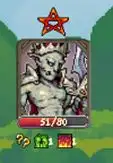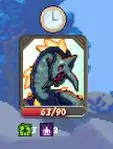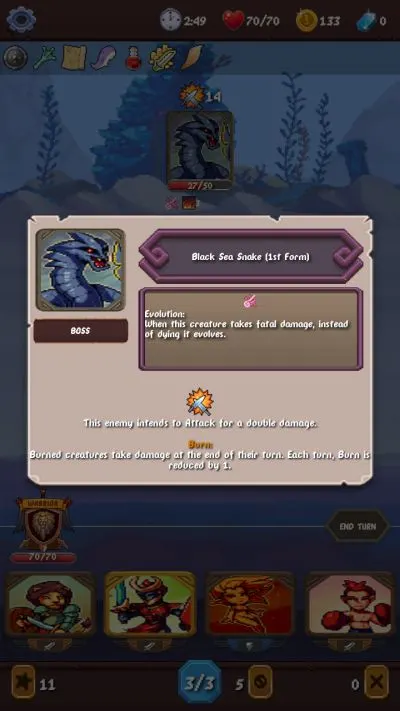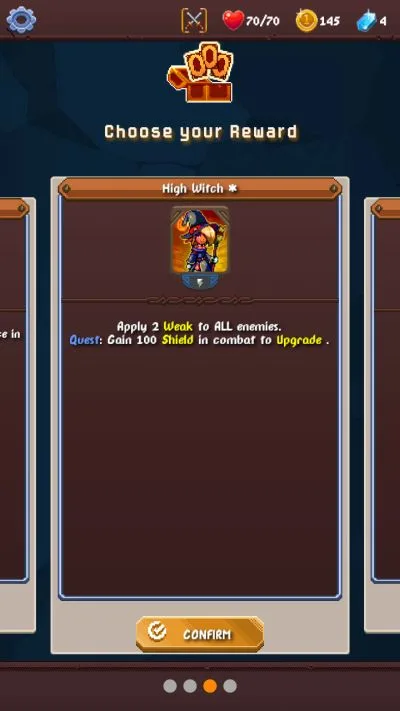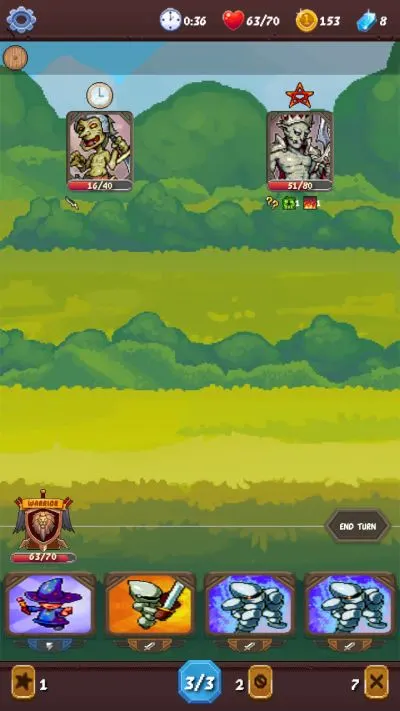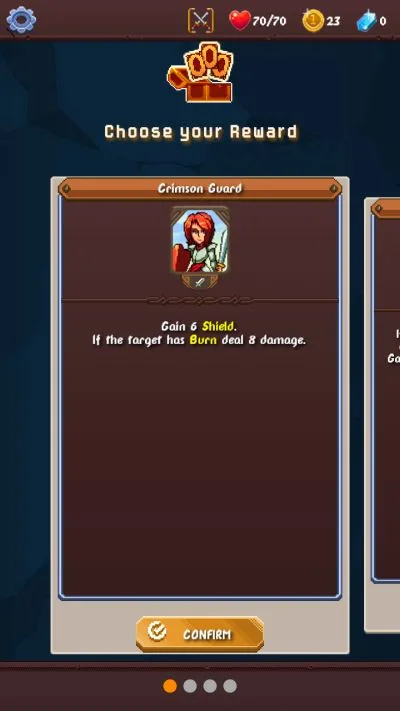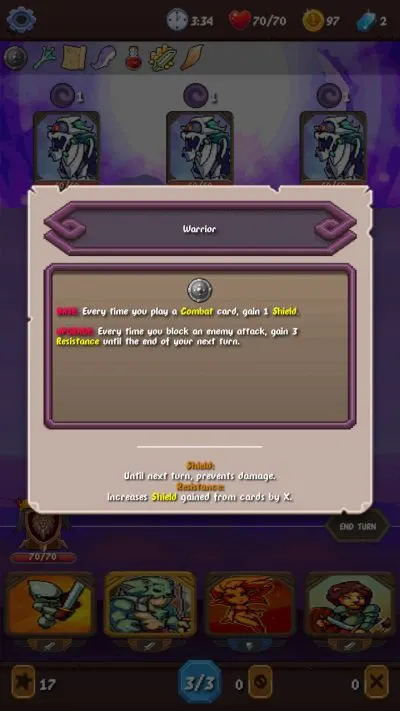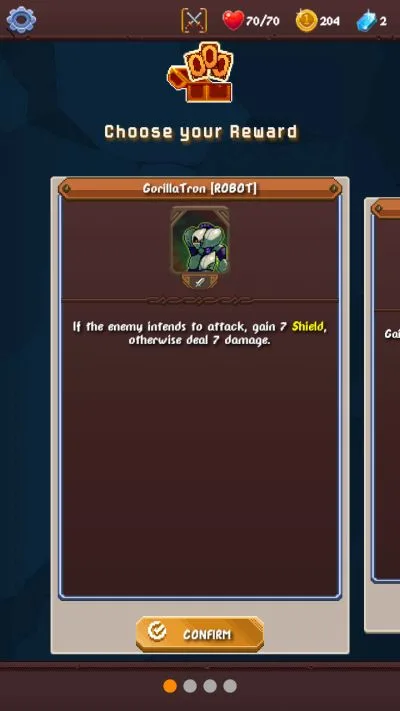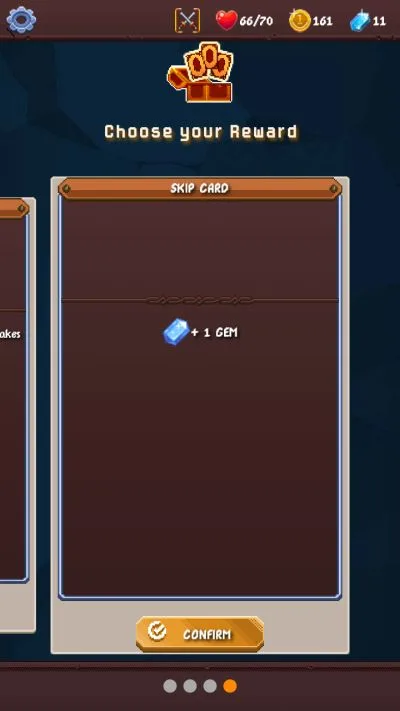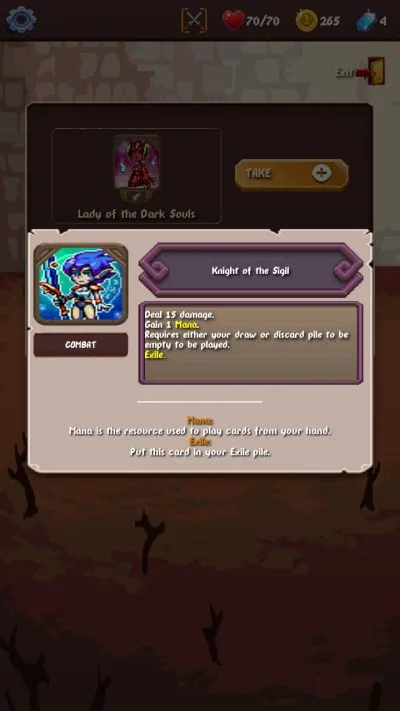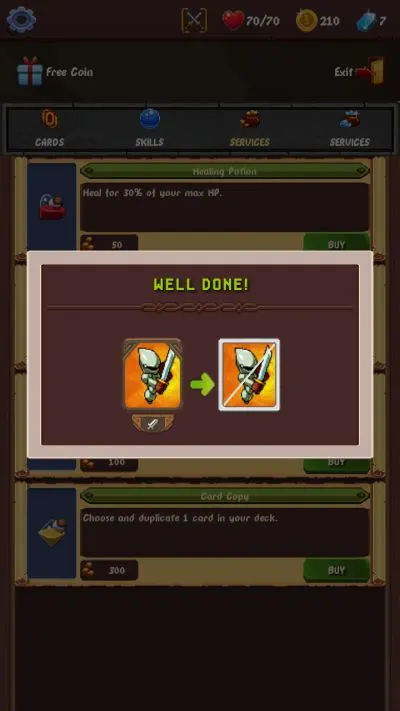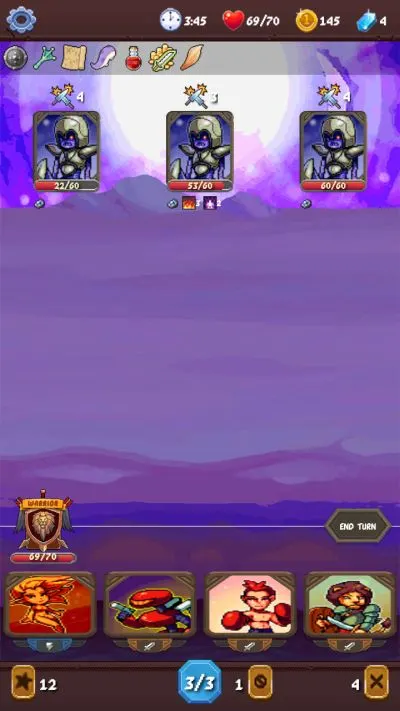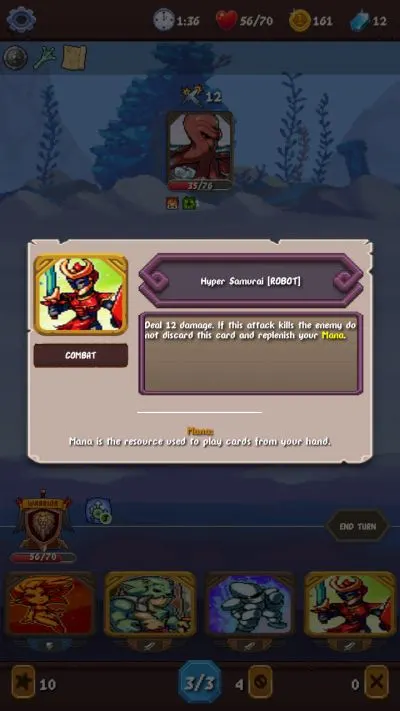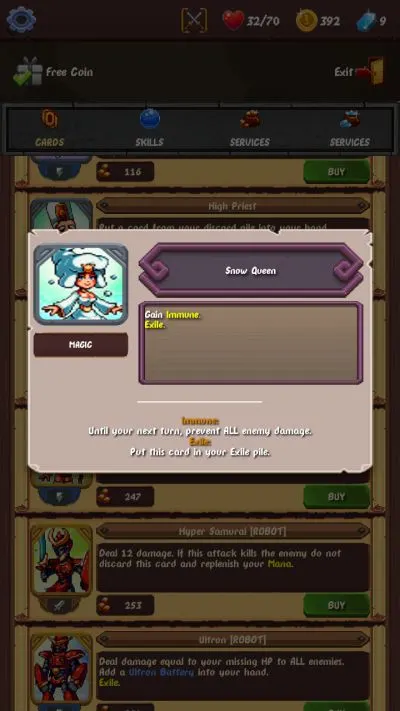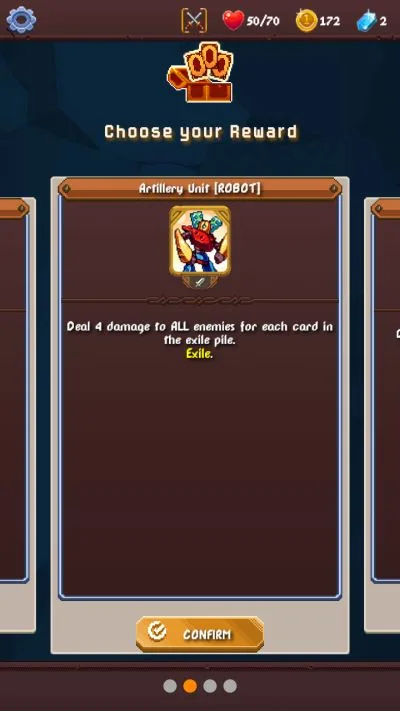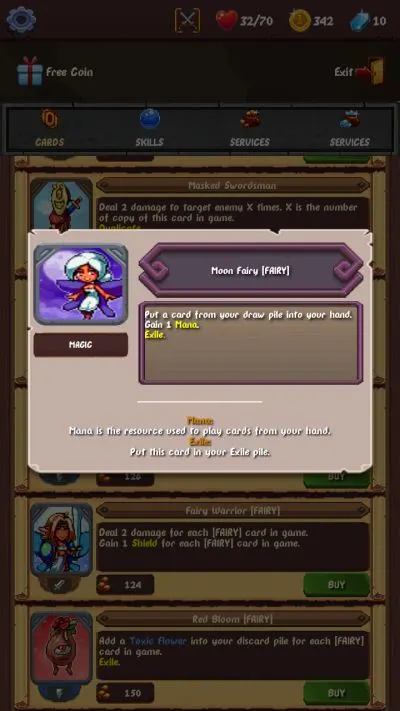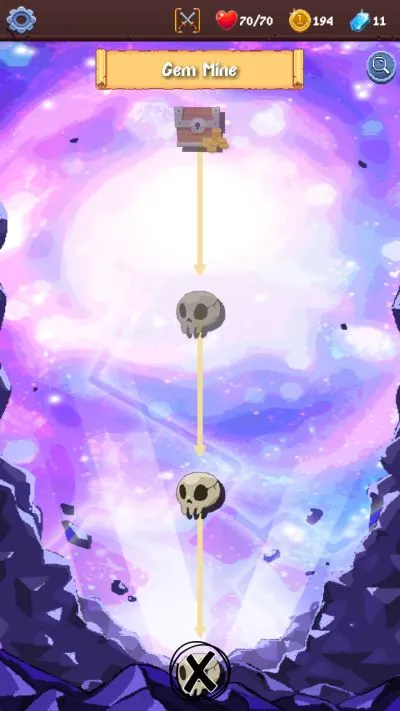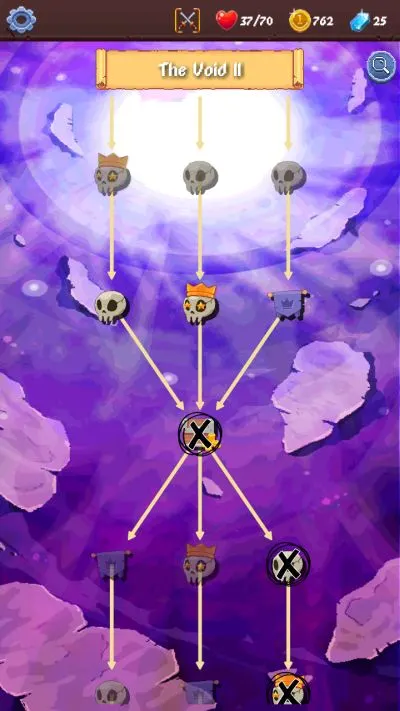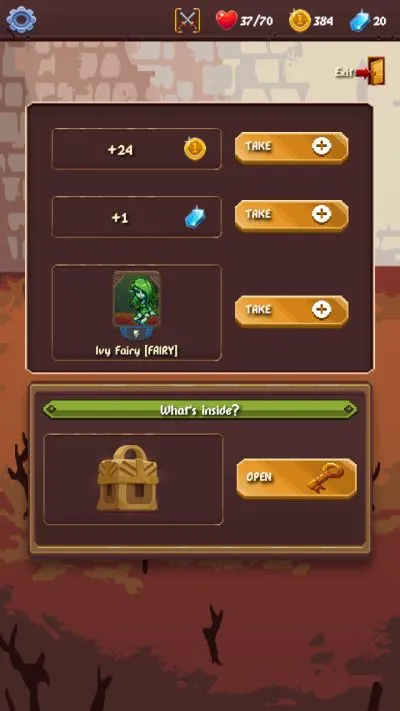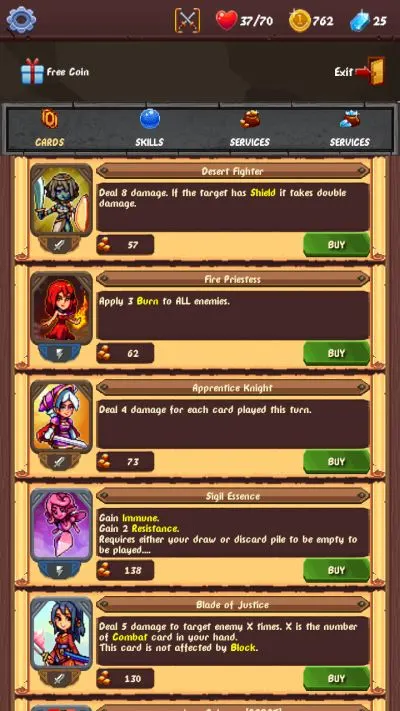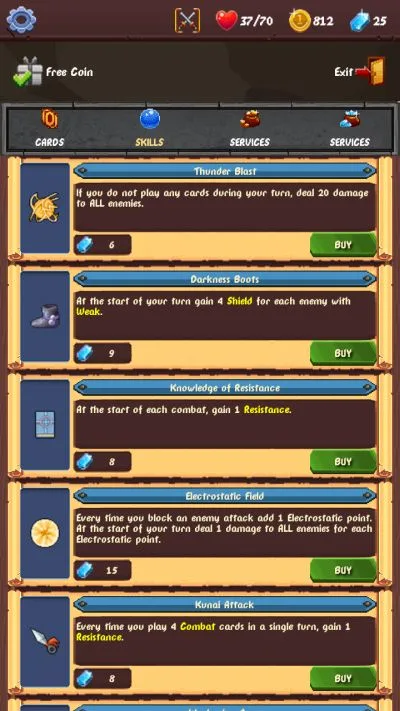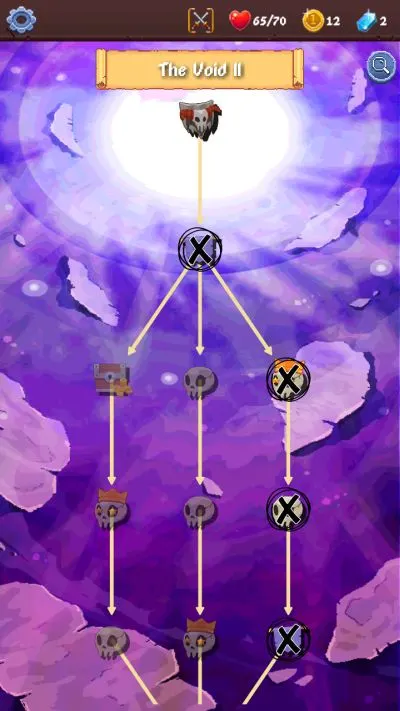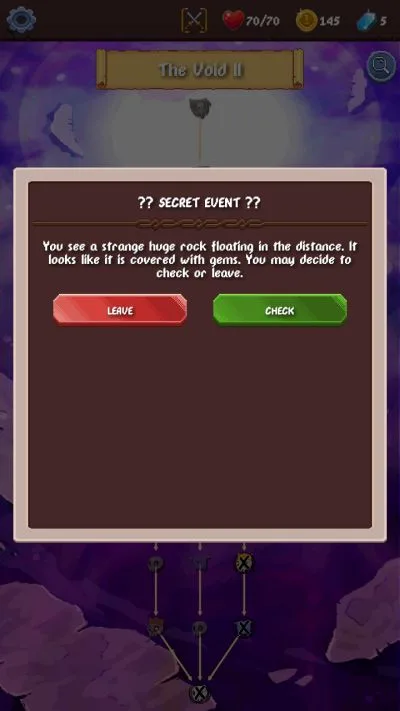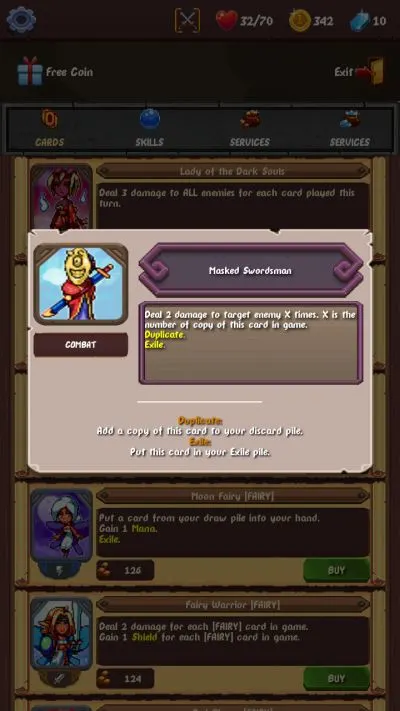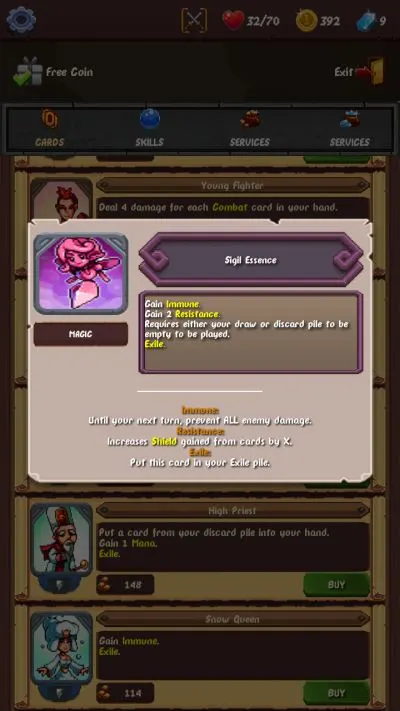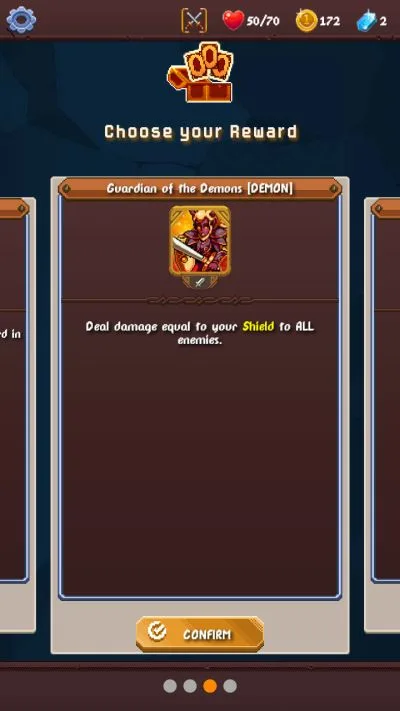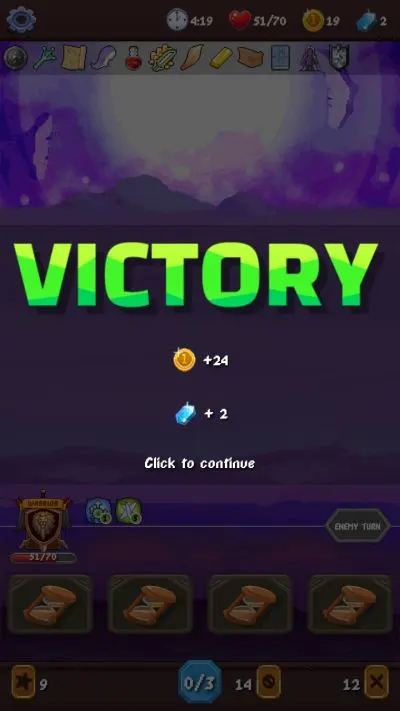Awaken, heroes! The evil lord of darkness has arisen, and it’s up to you to stop him! Unfortunately, we don’t have weapons, nor magic…but we do have cards.
Rogue Adventure is a deckbuilding roguelike game that’s available on both iOS and Android platforms. It’s very similar to other roguelike deck builders, such as Slay the Spire or Roguebook (both of which are excellent games to play on PC and mobile, by the way), and uses much of the same mechanics as those games. If you’ve ever played either of those before, things will click into place very quickly.
If, however, you’re new to the deckbuilding roguelike genre, I bid you welcome, and enjoy your stay! There’s a lot to digest in these types of games, and very rarely do you win games just by playing decent cards at the right time. To help ease new players into the intricacies of Rogue Adventure, I’ve prepared a comprehensive Rogue Adventure beginner’s guide, that comes with a bunch of tips, tricks and strategies to build a powerdul deck and conquer your enemies!
Gameplay Basics
Before we get down to the nitty-gritty, we need to go over the basics of gameplay. Luckily, Rogue Adventure operates as a turn-based game, so we can easily break things down.
Playing Cards
During your turn, you’ll draw 4 cards from the top of your deck. Don’t worry about decking out – if you can’t draw 4 cards, your Discard Pile will be shuffled and put back into your deck zone any time you have to draw but can’t. Also, whenever you play a card from your hand, you’ll draw a new card from your deck to replace it.
There are two kinds of cards in the game – combat and magic. Combat cards are symbolized by a sword icon below their portrait, and work as direct providers of either damage or shield. Magic cards are represented by a lightning bolt, and these involve buffs, debuffs, and other effects.
You can play cards at any time during your turn. To play a card, drag it to the target if it deals damage, or if there’s no targeting (such as if it targets you or targets all enemies, or can only target the last enemy), drag it anywhere in the middle of the screen.
Mana and Card Piles
All cards cost mana to play. By default, all cards have a mana cost of 1. Your mana is represented by the fraction inside the blue crystal at the bottom of the screen.
You start with 3 maximum mana, meaning you can play 3 cards per turn if you don’t have any mana manipulation.
The star icon to the left of your mana is your current draw pile. You can tap on it at any time to see what cards are left in your deck (though not in the order they’re shown). The cancel icon shows your exile pile, while the x icon shows your discard pile.
Ending Your Turn
Once you’re out of mana, or are satisfied with your plays, you can end your turn by tapping the End Turn button on the right side of the screen. Once you do this, it will be your enemy’s turn.
The Enemy Turn
During the enemy’s turn, each enemy will perform exactly what their intents above their head will say. Each enemy has one move, and once all enemies have finished their action, it will be your turn again.
Know Your Enemy
While knowing your enemy is always an important step in any game, Rogue Adventure uses enemy intents to signify exactly what an enemy is about to do. This means that you can almost always come up with a play to counter whatever the game’s about to throw at you.
The Different Intents
Reading intents is core to mastering the game. These are located above their respective enemy’s portrait, so you’ll know who is planning to do what.
The giant butterfly has the swords icon above its head. This means it’s going to use its move to attack. The number indicates how much damage the attack will do.
The cocoon has the shield icon above its head. This means that it’s going to gain shield on its turn. Enemy shield functions just like yours – any direct damage is taken out of shield before health, and shield expires on its next turn. The number indicates how much shield the enemy is going to gain.
This purple swirly…thing above the electric moray’s head means that it’s going to use a debuff on us during its turn. You can’t tell what debuff that’s going to be, so memorization of enemies is key here. The number beside the debuff icons notes how many turns that debuff is going to last.
The Goblin King’s red star intent means that it’s going to use its turn to summon more monsters to the field. Summoner-type enemies can get out of hand quickly, so have a plan to burst them down or chip at them with status ailments before things get too crazy!
And no, not all enemies that are summoned are instantly defeated when the summoner dies. You’ll need quite a bit more strategy when facing summoners.
The clock icon on top of the black sea serpent means that it’s going to pass its turn and do nothing. Lucky me!
Special Abilities
Intents aren’t everything. Almost every enemy in Rogue Adventure possesses a special ability that they’ll use to complicate things.
To check what an enemy’s special ability is, tap on its portrait. Some of these abilities can be particularly lethal to certain decks, such as reflecting multi-hit damage or automatically removing status ailments. Always read your enemy’s special abilities, lest you want to suffer a quick and humbling defeat!
Master The Keywords
Keywords are written in yellow text on cards. At the start, you may get a little lost due to the game always offering one of three cards at the end of each match. Keywords can deal with status effects, buffs and debuffs, and can change how cards work. On a side note, if you want to see a card’s effects before adding it to your deck, you can tap on its portrait.
Keyword List
If you don’t feel like experimenting due to fear of losing a run (no judgment, I’ve been there before), here’s a list of the keywords and what they mean, as well as what they do.
Armored: Armored is a status effect that ticks down by 1 at the start of your turn. While you have armored, your shield is not reset to 0 at the start of your turn.
Blind: While blinded, you cannot see enemy intents.
Block: Block (don’t confuse this with the defensive stat, Shield) is a status effect that can only be inflicted on the player. While blocked, your combat cards (the ones with a sword) have no effects – but they will still cost mana, so watch out!
Burn: Characters that are burned take damage equal to their burn stacks at the end of their turn, then their burn stacks are lowered by 1. Note that because this damage occurs at the end of a turn, this damage can be shunted with shields.
Combo: If you’ve played the other cards listed on a card’s combo, that card also applies its combo effect when played.
Courage: A card’s courage effects are activated if it’s the first card you play on your turn.
Double Damage: While you have double damage…your damage is doubled.
Duplicate: When this card resolves, add a copy of it to your Discard Pile.
Exile: When this card resolves, it goes into the Exile pile instead. Exiled cards aren’t shuffled back into the deck and remain there for the duration of the battle.
Frail: While you have frail, you gain 50% less shield from cards that grant it.
Heal: Cards that heal restore your health by that amount. Your HP cannot go above its maximum.
Immune: While you have Immune, you take 0 damage.
In the game: While this isn’t a highlighted keyword, I thought I may as well include it here. Any card that’s in your deck (whether in the draw pile, your hand, or discards) as well as in Exile are considered to be in the game.
Overcharge: If you have Overcharge, you cannot gain any more mana during this turn. Instead, any extra mana gained is converted to Strength and Resistance on a 1:1 scale (1 mana = 1 Strength and 1 Resistance).
Party: Your party size is equal to the number of racial faction cards you have in play. Racial factions are Angels, Beastmen, Demons, Fairies, Robots, and Ancients.
Poison: Characters that are poisoned take damage equal to their poison stacks at the start of their turn, then their poison stacks are lowered by 1.
Quest: Cards with Quest have a specific condition attached them. Once this condition has been met, the card receives a boost in its abilities.
Remove: When this card is played, remove it from the game. This is like the Exile Pile, but more permanent. This keyword usually appears on status cards that enemies like to cram into your deck.
Resistance: Whenever you gain shield, you gain X more, where X is how much Resistance you have.
Strength: Whenever you deal direct damage, you deal X more, where X is how much Strength you have.
Thorns: Whenever you’re attacked, deal damage to the attacking enemy equal to your thorns stack. Thorns stacks do not count down.
Weakness: An enemy with weak does 30% less damage. If you have weak, you deal 50% less damage. Not fair, I know.
Deckbuilding Is Key
Your deck serves as both your offense in defense in Rogue Adventure. Treat it with respect and care, and it’ll see you through even the toughest battles.
Classes and Passives
Rogue Adventure does have classes, although it may not seem like it. Each of these classes comes with their own class passive, which can be upgraded at a merchant. These class passives provide powerful key bonuses that often dictate what decks are not only feasible, but especially potent when played with that class.
For reference, the Warrior is the starting class in Rogue Adventure, and its class passive causes all combat guards to give 1 shield, in addition to its other effects. Gameplay-wise, this means that the Warrior can be a little more careless with their attacks, as they’re guaranteed to have at least 3 shield at the end of the turn if they only play combat cards.
To unlock more classes, you’ll need experience points. To get these, you’ll need to complete a run, whether that’s by defeating the final boss or losing.
Adding Cards
The first and most obvious way to manipulate your deck is by adding cards. At the end of each combat, you’ll be given a choice of 3 cards to put in your deck. These cards are of random rarity (bronze for common, silver for uncommon, gold for rare), but in general, you get silvers from elite fights and golds from boss fights.
One thing I will add here is that you should get the Torch skill from the merchant as soon as you can, as this increases the prize pool to 4 cards – that one extra card choice can make a huge difference.
Skipping Cards
Note that you don’t have to take a card if you don’t want to. The end-of-combat card reward can be eschewed in favor of one gem. For treasure rooms, you can always tap Exit at the top left of the screen if you don’t think the card in the room is a good fit for your deck.
Remember – a bloated deck is just as a bad an enemy, if not worse, than the fiercest monster. Constantly drawing cards you don’t need can quickly cause a fight to spiral out of your control and into the game over screen.
Removing Cards
The first time you see the option to remove cards in the merchant’s shop, you may ask, “why?” – which becomes “why not?” after a few more runs. Because, in all honesty, your starting cards are crap.
A smaller deck size also means that your deck will be more consistent in yielding the cards you actually need in a fight. But like all things, exercise moderation here – if the only dedicated shield cards you have are the starter cards, don’t remove them!
However, I will always highly suggest removing the basic attack cards from your deck, simply because you’re going to add much better and much more specialized cards that deal damage in line with your strategy down the line.
A word of warning here though – each time you remove a card, the merchant will add 50 gold to the price tag of this service. Another thing you should be wary of is that you can only remove a card once per merchant visit.
Play with A Deck In Mind
Make it a practice to play with building a particular deck in mind. You can ignore this advice in the first floor, as the cards given to you will be random – but you can use those cards to see what decks you have a solid foundation for.
At the same time, it’s not always good to skip every single card. If you see a card that’s generically good like Young Fighter, don’t hesitate to take it. Even with a deck in mind, you’ll still need to assemble the cards that compose its core, and if you can’t survive until then, all your planning will have been for nothing.
Exile
The first time you see a card with exile, you’ll think to yourself, “oh great, I can only use this once”.
But that’s the beauty of exile cards. Most buff cards exile themselves, meaning that you only need to play them once in a battle, and they’ll apply their effects while removing themselves from your deck, making it more consistent and allowing you to execute your core strategy.
Other cards that exile themselves usually work in tandem with cards that require a certain number of exiled cards. Artillery Unit, for example, deals 4 damage to ALL enemies times the number of exiled cards you have.
Moon Fairy and High Priest
Two of my absolute favorite cards that I have to name drop are Moon Fairy and High Priest. These two are searchers, meaning they pull cards from pools into your hand – Moon Fairy pulls a card from your deck and High Priest does it from your discards.
What’s even better is that both of these cards give you 1 mana (essentially refunding their cost) AND they exile themselves. No matter what deck I run, I always try to include one copy of each as they can make or break games by themselves.
Study The Map
Rogue Adventure gives you a choice as to which rooms you wish to visit, so you can’t complain that you weren’t ready or prepared for what the game throws at you. While you can’t backtrack, you can always view the map ahead of you and what rooms are going to be in the path you take, so use this to your advantage.
Enemy Encounters
Most rooms will contain enemies, which are denoted by skulls. There are two kinds of enemy encounters – regular ones with a regular skull, and elite enemies which are signified with a crowned skull with stars in its eyes.
Defeating monsters nets you cards and resources, with elite enemies giving more resources and uncommon card choices. I make it a point to tackle elites whenever I can, as the pros far outweigh the cons, and like most battles in this game, fighting elites becomes easier with experience.
Treasure Rooms
Treasure rooms are represented by a treasure chest. These room always contain some gold, some gems, and a card. Treasure rooms also have an extra chest that can be unlocked by watching an ad. Do make it a point to watch the ad as doing so gives you another payout of coins, gems, and a card. Remember though – if you don’t want to take the card, you don’t have to. You can leave at any time by tapping Exit on the upper left.
Merchants
Merchants provide a much-needed reprieve from the rigors of combat and exploration. These rooms are denoted by a purple scroll in the map screen.
At merchants, you’ll be able to spend your hard-earned coins and gems to buy a variety of things to help you in your quest.
Coins will buy cards (usually 3 of each rarity, chosen randomly) and services, such as healing, increasing your maximum HP, gaining temporary strength and/or resistance, card removal, card transformation, and card duplication. You can also upgrade your class skill here for a cost of 300 coins.
Gems, on the other hand, let you buy skills – powerful passive items that can completely change how a deck works and make or break a build. Do note that you can also reroll a shop’s card and skill stock once per shop, under the rightmost services tab.
While you’re at a merchant, make sure to watch the ad by tapping the Free Coins icon on the upper left – this gives you 50 more coins to spend as you please.
Because you can’t backtrack, try to avoid paths that bring you to merchant rooms if you have no money to spend. And if you’re gunning for rare cards, try to have at least 300 gold with you.
Boss Rooms
Boss rooms are the final chamber in each act, and it’s here that you’ll square off with an especially fierce opponent. These range from just being huge brutes that hit especially hard to tricky squads of enemies that complement each other.
Don’t hold back when fighting bosses – victory will not only grant you a large sum of gold, but it’ll also give you only rare cards in the reward selection screen. Defeating a boss also heals you to 100% of your health, if you’re not playing on higher difficulties.
Random Events
The one thing you can’t predict as you travel the map is the occurence of random events. These can be simple one-off battles to mini dungeons that give you more loot as you go. A good rule of thumb as to whether or not you should choose to do a random event is if you’re having difficulty in your current chapter – if you’re already having a tough time, why invite a battle you might not win? Act 4 dragons, I’m looking at you.
Deck Ideas
Finally, if you’re struggling to finish the game, here are some of the decks I normally use to finish the game. Do note that these are built as I go – by the end of chapter 2, I usually already commit to a deck type based on what cards I do have.
Masked Swordsman Deck
The Masked Swordsman deck was the first deck I used to complete the game.
This simple, unassuming card looks weak at first glance – until you read the description. Masked Swordsman does 2 damage X times, where X is the number of Masked Swordsman in the game. It also has duplicate and exile, meaning that while playing Masked Swordsman does add a copy to your deck for the duration of the battle, the copy you’re playing exiles itself, so your deck size doesn’t bloat.
You’ll want 3-4 copies of Masked Swordsman so that at the very least they’ll do as much damage as a basic attack card. While this deck does have an admittedly slow start, it excels at picking off bosses and elites, and few things are as satisfying as erasing 40+ health in a single attack.
Because of Masked Swordsman’s multi-hit nature, this deck benefits massively from any strength boosts. It also has good synergy with robot cards, especially Artillery Unit, which does 4 damage to ALL enemies times the number of exiled cards you have.
This deck is also quite easy to build as Masked Swordsman is a common card, meaning that you’re likely to find it along the way.
Shield Deck
What better way to get mileage out of all the shields you’re generating than to use them to attack? The Shield deck relies on that principle, using large amounts of resistance to gain staggering amounts of shield, then turning that shield against foes using certain cards.
This deck will benefit a lot from Sigil Essence, which gives you 2 resistance as well as a one-turn immune buff. Since that’s a sigil card you’ll need some deck manipulation to play it, so cards like Moon Fairy or High Priest are very welcome here, and I’d recommend running around 2 copies of 1 of those searchers.
To cap it off, you’ll need at least one copy of Guardian of the Demons, a rare Demon card that causes you do deal damage to all enemies equal to your shield.
This deck does have some downsides – you’ll need the rare Guardian of the Demons to deal major damage, and it can be slow as you set up your buffs and exile your one-use cards. Nonetheless, this deck does offer a lot of consistency and can handily win both corridor fights and bosses.
Practice and Have Fun!
There’s quite a bit of a learning curve in Rogue Adventure. With so many cards, characters, and archetypes to try out, enemies to discover and random encounters to unearth, it’s safe to say that once Rogue Adventure has your attention, you’ll be playing it for a long, long time. And of course, the non-intrusive ad scheme helps a lot!
With that. the Rogue Adventure beginner’s guide comes to an end, and I hope you learned something that will help you see that sweet, sweet final victory screen. If you have any comments, suggestions, or just want to share something, make yourself heard in the comments below!

